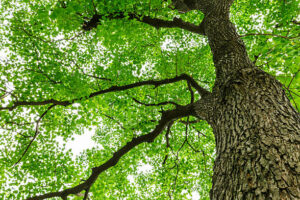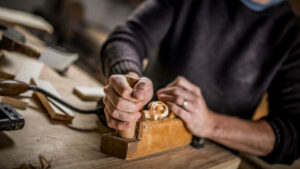Wood grain patterns give perfect wood and each piece of lumber a unique appearance. They can add a natural, rustic appearance to any project.
The different types of wood grain patterns include straight, wavy, interlocked, and irregular. Knots, burls, and crotch wood can also characterize them. They are the result of closed grains of varying cellular composition and structure.
Straight Grain
Woods with straight grain have consistent fiber arrangements that run in a linear direction along the plank. These are the types of woods that provide the strength and stability used in structural components like furniture legs, tables, and cabinets. They are easy to work with, offering an aesthetic that’s versatile and suitable for many applications. Straight-grain woods are also available with their unique pattern patterns that add visual contrast and interest to decorative elements or veneer pieces.
Closed grain occurs when wood species develop slowly, and their pores are small or tightly spaced with tight grain. This gives them a smooth, subtle appearance that works well in more modern and sleek environments. Some examples of closed-grained woods include maple, basswood red oak, and holly.
Open grain describes woods with large pores that vary in size from season to season, creating a more natural, rustic look. This type of unique pattern of grain is found in oak and ash, among others.
Wavy grain can occur in a tree that grows a wide range of grain types of trees, including walnut, ash, and European beech. It is a characteristic that’s generated by tumultuous growth patterns in the tree, such as when winds and rain create stresses within the wood.
Irregular grain refers to a wood’s fibers that twist or spiral abnormally. This can be due to several factors, including knots, burls, and big branches detaching from the tree trunk itself. This kind of figure is a popular design feature in woods like maple, birch, and hickory.
The easiest way to identify the direction of a wood’s vertical grain is to use a simple technique for identifying fabrics. Hold the fabric against a light source and stretch it. If it stretches, then it’s the cross grain; if it stays firm, then it’s the lengthwise or straight grain.
While straight white oak and wavy grain woods offer similar durability properties, flat grain lumber has a more consistent, orderly appearance that’s popular for people who want sleek flooring designs. This type of grain is created when woodcutters cut a log into planks at a 90-degree angle from its center rings. It is less costly than figured woods while still maintaining a similar level of durability.
Curly Grain
As woodworkers, we love the unique patterns and textures that come from a wavy or curly grain. These characteristics are known as figures and can add character to even the most mundane pieces of wood grains or lumber. The figure can also make silver grain on a piece of wood a desirable material to work with as it can be very resilient and durable against wear and tear, making it ideal for applications that require durability, such as cutting boards or butcher blocks.
Curly grain is a form of figure that occurs when ray cells grow in an unusual or twisted manner. This wavy or spiral figure can occur in all species of hardwoods but is most common in maple wood, walnut, cherry, and oak. An injury to the tree does not cause this pattern but rather a bending of the wood, which causes the fiber layers within the cell to undulate back and forth in waves.
These waves then interlock with each other to create a wavy or spiral pattern. Curly grain can be a subtle pattern that only shows up when viewed at an angle, or it may be more pronounced. In some cases, a piece of wood with this figure can be very dense and heavy, which adds to its durability.
Some of the most well-known types of figures include burl, eyeball, spalting, and tiger stripe. Burls are formed when an abnormal wart or balloon-shaped growth develops at the base of a tree’s growth rings or in the crotch of some trees. Burls often have a swirling or laced appearance and are often used to produce veneer.
Eyeburls are similar but usually lack the dramatic eyes that make Burl one of the most popular types of figure. Spalting is a figure pattern caused by fungus and can be quite striking. The characteristic black streaks that run parallel to the grain-sawn wood are an attractive feature of this figure and it is often used to produce beautiful veneer.
A Tiger stripe is a wavy or ribbon-like figure that is found in some maples. It is a highly desired figure and works well with most finishing techniques. This type of figure can also be seen in some hickory and can be more prominent in heartwood than sapwood hard maple.
Bird’s Eye Grain
Bird’s eye is a special pattern that occurs inside many types of wood, most notably in the hardwood species of maple. It is a distinctive design that resembles small, whirling eyes disrupting the graceful lines of the grain. While it may look similar to a burl, it is quite different because the tiny knots that create the burl are missing.
Wood with this unique figure is often prized for its beauty, as it can add personality to furniture and other pieces of woodwork. In addition, it is a good choice for use on a lathe because of its ability to be turned into decorative canes and chair legs. It also works well for making musical instruments, such as violins and drum shells.
This figure is caused by the interplay of rays and medullary fibers, which are the structural elements of wood fibers that make up the wood. This is why a piece of wood with this figure can have such a variety of colors and patterns. The color of the swirls can range from light to dark, and the density can vary as well—from a sparse scattering of eyes to an entire galaxy of eyes.
Although the wood with this figure is beautiful, it is not as stable as unfigured wood generally straight up. This can be a problem if the wood is used for flooring, as it can buckle or split over time. It is also difficult to stain, as the swirls and circles can disrupt the flow of the stains and dyes.
Wood with this figure is not widely available. It is usually sold in the form of veneer, which can be a very expensive way to make wood floors get this appearance. Some of the more pronounced examples can sell for thousands of dollars. However, the less pronounced versions are available in some hardwood lumber yards, and they are an affordable option for anyone who wants to use this material in their home or business.
Irregular Grain
As woodworkers, it’s important to have a strong grasp of different types of wood grain types and patterns to make informed decisions about the lumber we use for our projects. Not only does this impact the visual quality of our final pieces, but it also has a direct impact on the strength and suitability of the wood for its intended purpose.
Irregular grain refers to a wood’s unusual grain or pattern that twists and turns in a non-linear fashion. Knots, burls, and a variety of other deformations in the timber generate this type of figure. Examples of this include bird’s eye (a wavy pattern of eyes in the grain that is typically found in maple trees) and crotch wood (a result of large branches detaching from the trunk). This type of timber is also often used for decorative purposes, as it can add a unique and beautiful aesthetic to your furniture pieces.
Another example of irregular grain in fruit woods is spiral grain. This is a twisted pattern of either left- or right-handed spirals in the wood’s fibers and cells. This type of coarse grain of wood is often seen in larch and horse chestnut.
Finally, wormy wood is a result of the presence of worms that chew their way through the timber. This results in a distinctive texture and pattern that is often used to produce high-end decorative wood flooring.
Understanding different types of wood grain patterns is crucial for any woodworker, from beginners to seasoned professionals. It allows them to select the lumber that is best suited for their projects and helps them achieve visually stunning and durable finished products. By taking the time to learn about these different wood grain types and patterns, you can be confident that your projects will be a success. Whether you are working with a wood plane, chisel, or cutter, the proper selection of lumber will ensure that your work is completed quickly, effectively, and safely.






